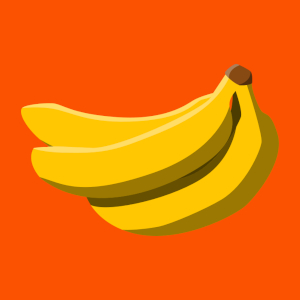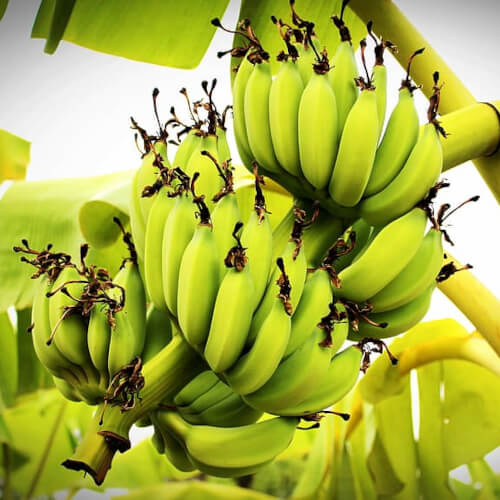



A banana is a fruit from any of several species in the plant genus Musa, which is native to the tropical regions in Southeast Asia. The plants they grow on are often called "banana trees," but they are actually giant herbs that can grow to around 3 m (9.8 ft) tall. The fruits themselves have a tough outer peel and a soft, fleshy interior, with tiny black seeds dotting the middle.
Bananas are often eaten by humans and are an excellent source of vitamins and minerals, especially potassium, which helps keep our muscles and nerves working properly. They also have fiber, which is important for a healthy digestive system. Bananas can be eaten on their own or used in a variety of recipes, from smoothies to baked goods.
Bananas have been cultivated for thousands of years. They were first domesticated in Southeast Asia and have since spread to various parts of the world. In ancient times, bananas were valued for their nutritional benefits and were even mentioned in early written records. Arab traders introduced bananas to the Middle East and Africa, and later European explorers brought them to the Americas.
Today, bananas are grown in many tropical and subtropical regions around the globe. Countries such as India, China, and the Philippines are among the top producers of bananas worldwide. The cultivation and export of bananas have become important industries, providing livelihoods for many people.
While you're probably familiar with the yellow bananas commonly found in supermarkets, there are actually several different types of bananas. Here are a few examples:
Unlike humans, monkeys often peel bananas from the bottom instead of the stem. They start by holding the banana with one hand and use their other hand to pinch the tip at the opposite end. This almost always results in a perfectly-peeled banana. So, while it's true that monkeys don't often encounter bananas in the wild, they sure do know how to enjoy them!
Instead, they're what scientists call an "herbaceous plant." Herbaceous plants are different from trees because they don't have woody stems or branches that grow thicker over time. Instead, they have soft, fleshy stems that grow quickly and are replaced each year.
Banana plants grow from underground bulbs called corms, and their stems are made up of tightly packed leaves that wrap around each other. As the stem grows taller, it produces new leaves at the top, which is where the bananas themselves grow. Once a banana plant has produced bananas, it will stop growing and eventually die back, but new plants can sprout up from the corms to continue the cycle.
Most of us know that as bananas ripen, their peels can turn from green to yellow, and eventually to brown or even black. But it turns out that's not all! Some bananas have naturally different colored peels. For example, the Red banana has a reddish-purple peel, the Blue Java banana has a bluish-grey peel when not quite ripe, and the Velvet Pink banana even has a pink peel!
When we think of berries, we often picture small, round fruits like strawberries, raspberries, and blueberries. But, as it turns out, scientists classify berries as any kind of fruit that grows from a single flower and has seeds inside.
Because of this, bananas are berries too, even though they look very different! Bananas grow from a single, pretty unusual-looking banana flower and have tiny black seeds inside—they're so small you might not even think of them as seeds.
On April 25, 2016, 30-year-old Andrew Lawrence shattered the previous 2 hour 58 minute record run by Patrick Wightman in the 2011 Barcelona Marathon. Dressed as a bright yellow banana, Lawrence completed the London Marathon in 2 hours, 48 minutes, and 41 seconds.
While it's estimated that there are over 1,000 varieties of banana grown today, by far the most popular is the Cavendish banana, making up approximately 47% of worldwide production. Up until the first half of the 20th century, however, the most common variety was the Gros Michel, or "Big Mike" banana. Gros Michel bananas had thick, study peels, and grew in large, dense bunches that made them easy to ship. In the 1950s, a fungus known as Panama disease all but wiped out production, forcing cultivators to switch to varieties resistant to the disease, including the Cavendish.
Opened in 1976 and located in Hesperia, California, the International Banana Club Museum once contained more than 17,000 banana items. Most artifacts were been donated by members of the official Banana Club, of which there are over 35,000 in 27 different countries.
As of 2022, the museum is unfortunately permanently closed due to complications from the COVID-19 pandemic.
Well, they contain the metal element potassium (K), which undergoes radioactive decay. But don't worry, you'd need to eat ten million of them in a single sitting to get sick.